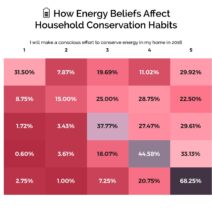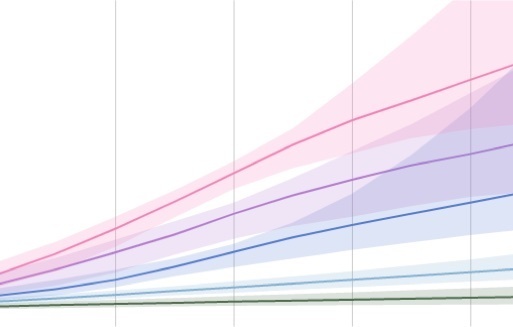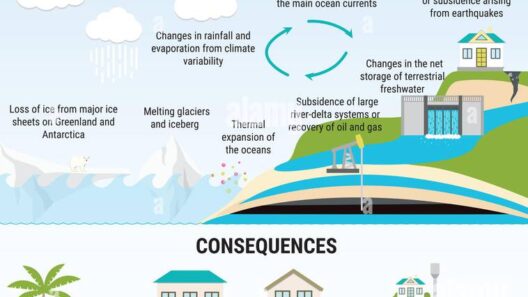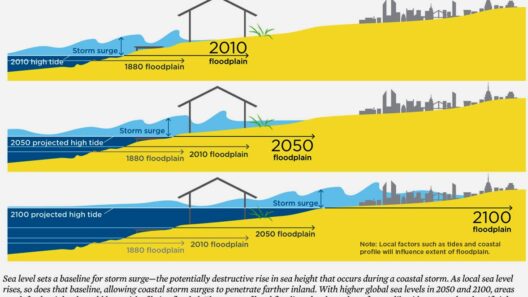In recent years, the phenomenon of rising sea levels has become an increasingly pressing concern for communities, industries, and ecosystems worldwide. As global temperature trends continue to escalate, the implications for coastal regions are underscored by a range of socio-economic and environmental challenges. This article delves into the complexities of the current state of global sea levels, exploring the causes, implications, and the urgent need for awareness and action.
Understanding sea level rise begins with a fundamental comprehension of its components. Sea levels primarily rise due to two principal factors: thermal expansion of seawater and the melting of ice from glaciers and polar ice sheets. As the Earth’s atmosphere warms, the oceans absorb heat, causing seawater to expand. Concurrently, the melting of ice contributes significant volumes of water to the oceans, exacerbating the issue.
The overarching consequence of these phenomena is not merely an environmental challenge. Communities situated in coastal areas are particularly vulnerable, with millions at risk from flooding, erosion, and habitat disruption. Furthermore, as sea levels rise, groundwater salinization becomes more pronounced, affecting freshwater supplies and agricultural productivity.
Recent scientific studies have revealed alarming statistics about sea level rise. According to satellite data, global sea levels rose approximately 8 inches (20 centimeters) in the last century, with recent projections suggesting an acceleration in this trend. The Intergovernmental Panel on Climate Change (IPCC) estimates that if emissions continue unabated, we could see a rise of 3 to 6 feet by the year 2100. These projections pose significant risks to low-lying countries and coastal cities, sparking discussions about adaptation and mitigation strategies.
Examining the Impact of Melting Ice
The polar ice sheets of Greenland and Antarctica are major contributors to current and future sea level rise. Research indicates that Greenland is losing ice at an increasing rate, releasing an estimated 280 billion tons of freshwater annually. Similarly, Antarctica’s ice sheets are beginning to destabilize, with glacier retreats and ice shelf collapses occurring more frequently. The repercussions extend beyond mere measurements of sea rise; they threaten ecosystems, disrupt local weather patterns, and strain international relations, especially among nations sharing water resources.
Coastal Communities on the Front Lines
For coastal communities, the stakes are high. Rising sea levels threaten infrastructure, homes, and livelihoods. In places like Miami, Florida, leaders are grappling with “sunny day flooding,” where high tides inundate streets even without rain. Property values decline, and as insurance becomes increasingly unaffordable or unavailable, residents face the grim reality of potential displacement.
Moreover, the socio-economic landscape is riddled with inequities. Vulnerable populations, often the least responsible for climate change emissions, disproportionately bear the brunt of rising waters. The threat of climate migration looms large, with millions expected to resettle, which could exacerbate tensions in receiving areas. Equitable solutions must be sought to address these disparities and ensure that communities most affected are included in decision-making processes.
Preventative Measures and Adaptation Strategies
Addressing the impending crisis of rising sea levels necessitates a multifaceted approach encompassing mitigation and adaptation strategies. On a macro level, reducing greenhouse gas emissions is paramount. Transitioning to renewable energy sources, enhancing energy efficiency, and rethinking urban planning can mitigate the root causes of climate change. Furthermore, enhancing public transport options and promoting sustainable agriculture can contribute to a decreased carbon footprint.
At a community level, adaptation strategies are crucial. Investing in infrastructure improvements, such as sea walls and flood barriers, can provide immediate relief to vulnerable coastlines. Additionally, engaging in habitat restoration—such as rebuilding wetlands—serves a dual purpose: protecting communities while enhancing biodiversity. Cities like New York are already implementing “green infrastructure” projects that help absorb excess rainfall and provide natural buffers against storm surges.
Involving Local Communities and Stakeholders
Public awareness and community engagement are vital components of any successful sea-level rise strategy. Grassroots movements and local activist organizations can foster a deeper understanding of the stakes involved. Educational campaigns can empower citizens to advocate for policies that prioritize sustainability and environmental justice.
As pressures from climate change intensify, the dialogue surrounding sea levels must expand to encompass diverse perspectives. Collaboration among governments, scientists, businesses, and citizens is paramount. By working together, it is possible to create holistic solutions that enhance resilience while promoting ecological integrity.
In conclusion, the issue of rising sea levels is not merely an environmental concern; it represents a complex web of social, economic, and political implications. Understanding the drivers of this phenomenon is essential for fostering informed community action and policy-making. As we advance into uncertain times, the global community must grapple with the challenges that rising seas present, working collectively towards sustainable solutions that honor both people and the planet.








